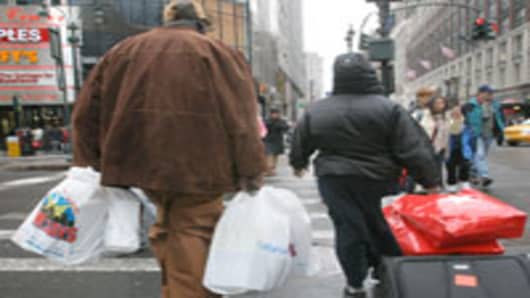When it comes to job losses in this recession, March will be the cruelest month, while April may be the beginning of the end of the misery.
“It almost can’t get any worse,” says economist David Jones of DMJ Advisors.
That much economists agree on. What happens next is another story.
Jones is forecasting a 675,000-decline in March payrolls—slightly worse than the 658,000 consensus of Briefing.com—when the government releases the latest employment data on Friday at 8:30 am ET (Payrolls fell 650,000 in February.)
The jobless rate is expected to rise to 8.5 percent—another 25-year higher, from 8.1 percent the months before. As is expected with a lagging economic indicator, the jobless rate will continue rising for most, if not all, of the rest of the year, say economists.
Still, at this relatively late stage in the year-plus long recession, economists are looking past Friday's report and to brighter days.
“I don’t see how we can sustain job losses this severe, never mind intensify them,” says Ken Goldstein, who follows labor and consumer trends for The Conference Board. “I don't see why or how business can sustain it.”
Such thinking is evident in the unusually quick ascent in the jobless rate—from 4.4 percent in March 2007 to 8.1 percent in February. Economists expect a high of 9.0-9.5 percent this year. By comparison, during the 1973-1975 and 1980-1982 periods, the rate didn’t quite double (4.6-9.0 percent, 5.6-10.8 percent.)
By most, though not all, measures, this recession has been the hardest on the labor market in the post-WWII period.
The economy has lost more than 4.9 million jobs from the peak employment level of 2007. Roughly 3.2 percent of the workforce has been eliminated, which is more than during the brutal Rust Belt recession of 1980-1982.
Goldstein speculates that businesses have been slashing jobs to preserve capital because of an inability to borrow amid a severe credit crunch, but those conditions are in the process of easing.
For that and several other reasons, as well as historical patterns, economists are forecasting improvement in the labor market along with the broader economy.
“Job losses tend to be very bad at the end of a recession,” says Bank of Tokyo-Mitsubishi’s chief financial economist Christopher Rupkey.
Rupkey notes that in 1991 and 2001 recessions, job losses peaked two months before the recessions technically ended. Interestingly enough, some economists are now calling for an end to this recession in April or May.
Economist Robert Brusca of FAO Economics points to a corresponding metric. Weekly initial jobless claims typically peak eight weeks before a recession ends. That points to a May ending.
Data released Thursday put them at a new record high of 669,000.
“The change in claims over past weeks has been slowing,” notes Brusca. “There’s a good chance this is a signal we're close to a peak.”
Jones says the bottom is near based on the pact that the depth of job losses tend to coincide with the biggest decline in GDP during any given recession and in this case that will be the first quarter. (The first government report on Q1 GDP won’t be out until April 19; Jones is forecasting a drop of 6.7 percent vs. the 6.3 peercent one of the fourth quarter of 2008.)
Jones sees job losses “stabilizing” around 650,000 in the short term, but others—Brusca and Goldstein—are more optimistic.
“I am still convinced that by June we'll be down to 200,000,” says Goldstein, who nevertheless expects the economy to shed jobs through the end of the year.
Brusca says the jobless rate is likely to peak in the next few months, not later in the year, as most expect.
“We've cut people at such a rapid rate, a lot of these people are going to go back to work pretty quickly,” he explains. “You’re going to get jobs put back on the book faster, with stronger growth much faster than people are expecting.”
Brusca and Rupkey say job growth is much more likely to register a healthy bounce back as it did following the 70s and 80s recessions, than continue the long declines that marked the post-recessionary periods of 1991 and 2001, known as a “jobless recovery.”
Here’s where timing and fundamentals converge.
Consumer spending has been bouncing back for a couple months, while the auto sector has just begun to show signs of life.
Government stimulus measures are also kicking in the form of tax cuts (about $8 a week for most wage earners) and lower mortgage rates which consumers are using to refinance their homes and thus translate savings on monthly payments into disposable income.
“If this spending leads to a pick up in revenue for corporations, it is something that could mitigate further job losses,” says Rupkey, somewhat cautiously. There may even be a psychological effect, say economists.
Optimists might point to layoff data from outplacement company Challenger, Gray & Christmas released Wednesday. Scheduled job losses fell 19.3 percent in March to 150,411, the lowest since October, right after the sudden collapse of Lehman Brothers.
Even economists who are skeptical about any big sudden improvement in underlying labor trends say the worst is here or at least near.
“We will soon see a stemming of the losses,” says Heidi Shierholz, an economist at the Economic Policy Institute. “I'm hopeful we'll see a much quicker bounce back than in 2001.”





